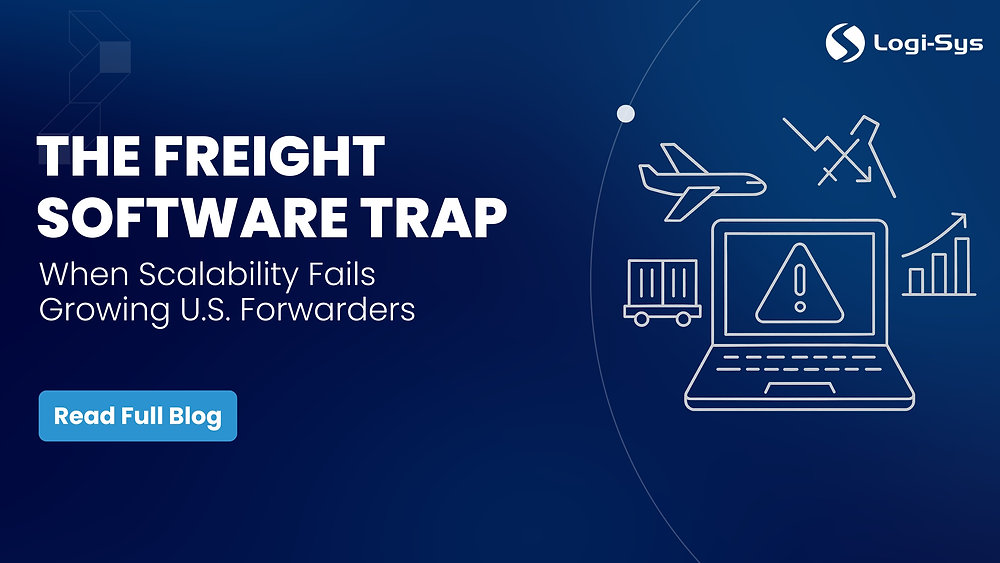
The Illusion of “Good Enough”
Most U.S. forwarders don’t realize they’ve outgrown their software — until it’s too late.
The system that once helped your team get started — the one with decent UI, basic job handling, or limited TMS functions — slowly becomes the bottleneck. You see it in delayed quotes. Lost visibility. Fragmented workflows. Missed compliance windows. Manual re-entry across tools. And growing IT overhead to “hold it all together.”
This is the trap many forwarders fall into: confusing software that works today with software built to scale.And in a logistics market defined by cross-border complexity, razor-thin margins, and rising customer expectations — that difference matters more than ever.
Where Freight Software Breaks at Scale
As operations grow — more customers, more lanes, more branches, more modes — many forwarders discover that their freight forwarding software wasn’t built to handle the expansion. Here’s how scalability failure shows up:
-
Disconnected functions: Your freight system can’t talk to your accounting, TMS, or warehouse. You rely on manual syncs and spreadsheets.
-
UI clutter & performance lags: Some freight forwarding software companies offer enterprise-ready systems that often feel bloated or slow under real-world load.
-
Agent coordination gaps: You’re still duplicating shipment data between overseas partners — wasting time and risking miscommunication.
-
Limited user roles & access control: New teams struggle with permissions or system errors as you scale to multiple branches.
-
Compliance fatigue: As regulations evolve, your system needs patchwork integrations or external consultants just to keep up.
In short: You scale. Your software doesn’t. And that creates operational drag, team burnout, and profit erosion.
Why Many Freight Forwarding Software Companies Miss the Mark
It’s not that there’s a lack of freight software in the U.S. market. In fact, that’s part of the problem — too many vendors offer narrow, disconnected tools.
-
GoFreight and Shipthis market themselves as startup-friendly and visually polished — but often struggle with multi-branch control, deep accounting, or advanced role-based workflows.
-
Magaya focuses on digital freight portals, but many users report fragmented modules and outdated architecture when scaling up.
-
CargoWise, while enterprise-grade, is notorious for slow implementations, high training overhead, and UI rigidity — making it difficult for fast-moving forwarders to adapt.
These aren’t bad freight forwarding software by any means — they just might be purpose-built for businesses who want true process control, cross-functional visibility, and long-term scale.
It’s not just a freight system with a few bolt-ons. It’s a unified platform that connects your sales, operations, customs, billing, accounts, agents, and customers — all on a single database.
Here’s how Logi-Sys, a next-gen ERP for freight forwarders, delivers real scalability:
-
Multi-modal, multi-branch control: Manage air, ocean, and road shipments across multiple offices without duplicating effort or losing visibility.
-
Built-in CRM + Billing + Financials: No third-party software needed. All quotation, invoicing, cost sheet, and profitability reports come from one platform — and one source of truth.
-
Agent-to-agent data sharing: Logi-Sys Freight Job Share lets overseas agents exchange shipment data digitally — eliminating re-entry, reducing delay.
-
Role-based workflows: As teams grow, so does complexity. Logi-Sys offers customizable roles, user access controls, and audit trails to maintain governance.
-
Real-time customer visibility: With live dashboards and self-service portals, your customers stay informed — no more email chases or manual updates.
-
Cloud-native speed and support: No local servers, no long downtimes, and no drawn-out deployments. Just 24×7 access and logistics-trained support when you need it
-
24×7 omnichannel, domain‑trained support: Live, in‑house freight experts are available round‑the‑clock (call, chat, email) — from implementation to training and post‑sales care.
-
LogiBRAIN analytics engine: Freight-specific BI dashboards, revenue vs cost drill-downs, anomaly alerts, and trend analysis — built into the platform
-
Robust disaster‑recovery & business‑continuity: Softlink Global operates Class‑3/4 data centers (e.g., Houston, Frankfurt, Singapore) with geo‑redundant backup, 15‑minute syncs, and automatic failover within 45 minutes — minimizing downtime and risk
How Leading Forwarders Stay Ahead
Some of the most respected names in global forwarding — from Asia to the U.S. — trust Logi-Sys because it scales with them, not against them.
Whether you’re expanding from a regional hub in Dallas to West Coast ports, onboarding new warehouse locations in Chicago, or managing multi-origin imports to Florida — Logi-Sys adapts without bolt-ons or technical debt.
And because it’s cloud-based, mobile-ready, and built for speed, your teams spend less time “figuring out the system” and more time driving growth.
Final Word: Don’t Scale the Chaos
Software should never become a liability. Yet too often, growing forwarders pour more money, people, and custom code into systems that can’t grow with them.
And it’s time to fix it.
Logi-Sys: Freight ERP That Grows with You
From your first consolidation to your fifth branch office, Logi-Sys supports your operation end-to-end, without needing new tools, licenses, or tech overhauls.
It’s not just scalable. It’s sustainable.
